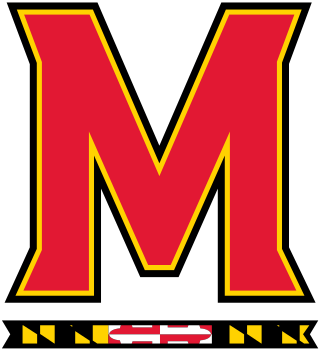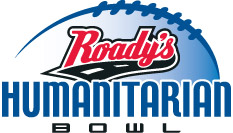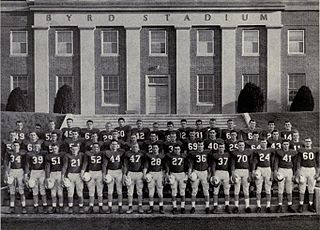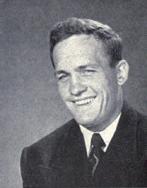Related Research Articles

Thomas Allison Mont was an American educator, university administrator, college football coach, and National Football League (NFL) player. He played quarterback for the Washington Redskins as a back-up behind Sammy Baugh for three seasons. Mont served as the head football coach for three years at the University of Maryland and eighteen years at DePauw University. He also served as the DePauw athletic director for fifteen years.
The split-T is an offensive formation in American football that was popular in the 1940s and 1950s. Developed by Missouri Tigers head coach Don Faurot as a variation on the T formation, the split-T was first used in the 1941 season and allowed the Tigers to win all but their season-opening match against the Ohio State Buckeyes and the 1942 Sugar Bowl versus Fordham. Jim Tatum and Bud Wilkinson, who coached under Faurot with the Iowa Pre-Flight Seahawks during World War II, brought the split-T to the Oklahoma Sooners in 1946. After Tatum left for Maryland in 1947, Wilkinson became the head coach and went on to win a record-setting 47 straight games and two national titles between 1953 and 1957.
The 2008 Maryland Terrapins football team represented the University of Maryland in the 2008 NCAA Division I FBS football season. It was the Terrapins' 56th season as a member of the Atlantic Coast Conference (ACC) and its fourth within the framework of the ACC Atlantic Division.

The Maryland–Virginia football rivalry is an American college football rivalry between the Maryland Terrapins and Virginia Cavaliers. The Terrapins and Cavaliers first met in 1919 and the series was played annually from 1957 through 2013, before Maryland left the Atlantic Coast Conference (ACC) for the Big Ten Conference in 2014.

The Maryland–West Virginia football rivalry is an American college football rivalry between the Maryland Terrapins and West Virginia Mountaineers. The two schools are strong rivals due to several factors, including similar recruiting areas and the relatively short distance between each other, approximately 210 miles (340 km) apart. The two teams first played in 1919 and the series ran uninterrupted from 1980 to 2007. West Virginia leads the series 28–23–2. The two teams met for the Gator Bowl for a rematch at the end of the 2003 season. Until the series lapsed in 2007, the game was the longest continuously running non-conference game for both schools. The two teams met again in Morgantown in 2015 and in College Park in 2021, with West Virginia and Maryland winning respectively.

The Crab Bowl Classic is the name given to the Maryland–Navy football rivalry. It is an American college football rivalry between the Maryland Terrapins football team of the University of Maryland and the Navy Midshipmen football team of the United States Naval Academy. The two institutions, located in close proximity in the state of Maryland, first met for a football game in 1905. Since then, the series has often been marked by controversy, with incidents by players and supporters occurring both on and off the field. The winner of the game is awarded the Crab Bowl Trophy.

The 2008 Humanitarian Bowl was a postseason college football bowl game between the Maryland Terrapins and the Nevada Wolf Pack on December 30, 2008. It was the two teams' first meeting. The game featured two conference tie-ins: the University of Maryland represented the Atlantic Coast Conference (ACC) and the University of Nevada represented the Western Athletic Conference (WAC). The game was played at Bronco Stadium in Boise, Idaho and was the 12th edition of the Humanitarian Bowl. It was sponsored by the New Plymouth, Idaho-based company Roady's Truck Stops, which claims to be the largest chain of truck stops in the United States.
The 1946 Oklahoma Sooners football team represented the University of Oklahoma as a member of the Big Six Conference during the 1946 college football season. Led by Jim Tatum in his first and only season as head coach, the Sooners compiled an overall record of 8–3 with a mark of 4–1 in conference play, sharing the Big 6 title with Kansas. Oklahoma was invited to the Gator Bowl, where they defeated NC State. With the aid of first-year backfield coach Bud Wilkinson, who became the team's head coach the following year, Tatum installed the new split-T offense.
From 1947 to 1955, Jim Tatum served as the head coach of the Maryland Terrapins football team, which represented the University of Maryland in National Collegiate Athletic Association (NCAA) college football. Maryland hired Tatum to replace Clark Shaughnessy after the 1946 season. Tatum had created both success and controversy during his one season as head coach of the Oklahoma Sooners football team. During his nine-year tenure, Tatum became one of the most successful head football coaches in Maryland history, and the Terrapins compiled two national championships, three conference championships, and five bowl game appearances. His teams compiled a 73–15–4 record without a single losing season, and as of the end of 2016, he has the highest winning percentage of any Maryland football coach who coached at least seven games. In 1954, the University of Maryland appointed a new president, Dr. Wilson Elkins, who chose to de-emphasize football. Following the 1955 season, Tatum took a pay cut to coach at his alma mater, North Carolina, and he died four years later.
The 1950 Gator Bowl was the fifth edition of the Gator Bowl and featured the Missouri Tigers representing the University of Missouri and the Maryland Terrapins representing the University of Maryland. It was the first-ever meeting of the two teams.
The 1950 Maryland Terrapins football team represented the University of Maryland in 1950 college football season as a member of the Southern Conference (SoCon).

The 1951 Maryland Terrapins football team represented the University of Maryland in 1951 college football season as a member of the Southern Conference (SoCon). Maryland outscored its opponents, 381–74, and finished the season with a 10–0 record, including three shut outs, and held seven opponents to seven points or less. It was the school's first perfect undefeated and untied season since 1893. Maryland also secured its first berth in a major postseason bowl game, the 1952 Sugar Bowl, where it upset first-ranked Tennessee under head coach Robert Neyland.

Bob "Shoo Shoo" Shemonski was an American football player. He played college football as an end and back for the Maryland Terrapins and was selected in the 1952 NFL Draft by the Chicago Bears.
The 1953 Maryland Terrapins football team represented the University of Maryland in the 1953 college football season in its first season as a member of the Atlantic Coast Conference (ACC). Maryland outscored its opponents 298–38 and recorded six defensive shutouts. Jim Tatum served as the head coach for the seventh year of his nine-year tenure. In the postseason, Maryland lost to Oklahoma in the 1954 Orange Bowl. The team was selected national champion by Associated Press, International News Service, and United Press International, leading to a consensus national champion designation.
Guilian Austin Gary is an American football coach and former player. He played college football at the University of Maryland, College Park where he was a star wide receiver. He was the first Maryland player lead the team in punt returning for four years, and the first since 1961 to lead the team in receiving for three years. Gary is most known for the last-minute touchdown reception he made during the 2001 season which secured the Atlantic Coast Conference (ACC) championship for Maryland.

The 2010 Maryland Terrapins football team represented the University of Maryland in the 2010 NCAA Division I FBS football season. It was the Terrapins' 58th season as a member of the Atlantic Coast Conference (ACC) and its sixth within the ACC's Atlantic Division. They played their home games at Byrd Stadium and were led by head coach Ralph Friedgen. Maryland finished the season 9–4 overall and 5–3 in ACC play. The Terrapins were invited to the Military Bowl, where they defeated East Carolina, 51–20.
The 1956 Maryland Terrapins football team represented the University of Maryland in the 1956 NCAA University Division football season as a member of the Atlantic Coast Conference. They were led by first-year head coach Tommy Mont, who had been promoted from backfield assistant after Jim Tatum left to take over at North Carolina. Preseason hopes were high for the team, but it suffered numerous injuries and other misfortunes. Maryland finished with a 2–7–1 record, and the Associated Press called it "one of the year's most disappointing football teams".
The 1957 Maryland Terrapins football team represented the University of Maryland in the 1957 NCAA University Division football season as a member of the Atlantic Coast Conference. They were led by second-year head coach Tommy Mont, who guided Maryland to a 5–5 record, which proved to be the only non-losing season in his three-year tenure. One highlight of the season was the attendance of Elizabeth II and The Duke of Edinburgh at the game against North Carolina.
The 1956 Orange Bowl was a college football bowl game between the Oklahoma Sooners and the Maryland Terrapins. It was played on January 2, because New Year's Day was a Sunday.

The Maryland Terrapins football team represents the University of Maryland, College Park in the sport of American football. The Terrapins compete in the NCAA Division I Football Bowl Subdivision (FBS) and the Big Ten Conference. The Terrapins joined the Big Ten Conference on July 1, 2014, following 62 years in the Atlantic Coast Conference as a founding member. The Terrapins are currently coached by Mike Locksley. Since 1950, the Terrapins have played their home games at Maryland Stadium in College Park, Maryland with occasional home games from time to time in Baltimore, making them one of two FBS football teams in the Baltimore–Washington metropolitan area and the closest Football Bowl Subdivision team to Washington, D.C. The team's official colors of red, white, black, and gold have been in use in some combination since the 1920s and are taken from Maryland's state flag, and the Terrapins nickname — often abbreviated as "Terps" — was adopted in 1933 after a turtle species native to the state.
References
- 1 2 Orange Bowl Results [ permanent dead link ], Fedex Orange Bowl Official Site, retrieved January 19, 2009.
- 1 2 Maryland vs Oklahoma, 1869–2007 Archived 2011-07-16 at the Wayback Machine , Stassen College Football Information, retrieved January 19, 2009.
- ↑ Oklahoma Bowl Recaps Archived 2007-10-27 at the Wayback Machine , Oklahoma Sooners Official Athletic Site, retrieved January 19, 2009.
- 1 2 3 4 Bowl Results [ permanent dead link ] (PDF), 2004 Maryland Gator Bowl Guide, p. 56, 2004, retrieved January 29, 2009.
- ↑ Records Archived 2011-05-23 at the Wayback Machine (PDF), 2007 Maryland Terrapins Football Media Guide, University of Maryland, p. 55, retrieved January 14, 2009.
- ↑ Past Football Rankings: 1950s Archived 2009-02-21 at the Wayback Machine , College Football Poll, retrieved January 29, 2009.
- 1 2 3 4 5 6 7 8 9 10 11 Harold Keith, Forty-Seven Straight: The Wilkinson Era at Oklahoma Archived 2016-04-02 at the Wayback Machine , 2003, University of Oklahoma Press, ISBN 0-8061-3569-7.
- ↑ "ACC Year by Year" Archived 2009-03-19 at the Wayback Machine (PDF), 2007 ACC Football Media Guide, Atlantic Coast Conference, 2007, accessed January 14, 2008.
- ↑ Oklahoma Historical Scores Archived 2015-08-12 at the Wayback Machine , Stassen College Football Information, retrieved January 19, 2009.
- ↑ Oklahoma has a long tradition of bowl games in Miami Archived 2011-06-17 at the Wayback Machine , Palm Beach Post , January 6, 2009.
- ↑ Past Division I-A Football National Champions Archived March 25, 2008, at the Wayback Machine , National Collegiate Athletic Association, retrieved January 29, 2009.
- ↑ 47-Game Winning Streak Archived 2010-06-27 at the Wayback Machine , University of Oklahoma Sooners Official Athletic Site, retrieved January 29, 2009.